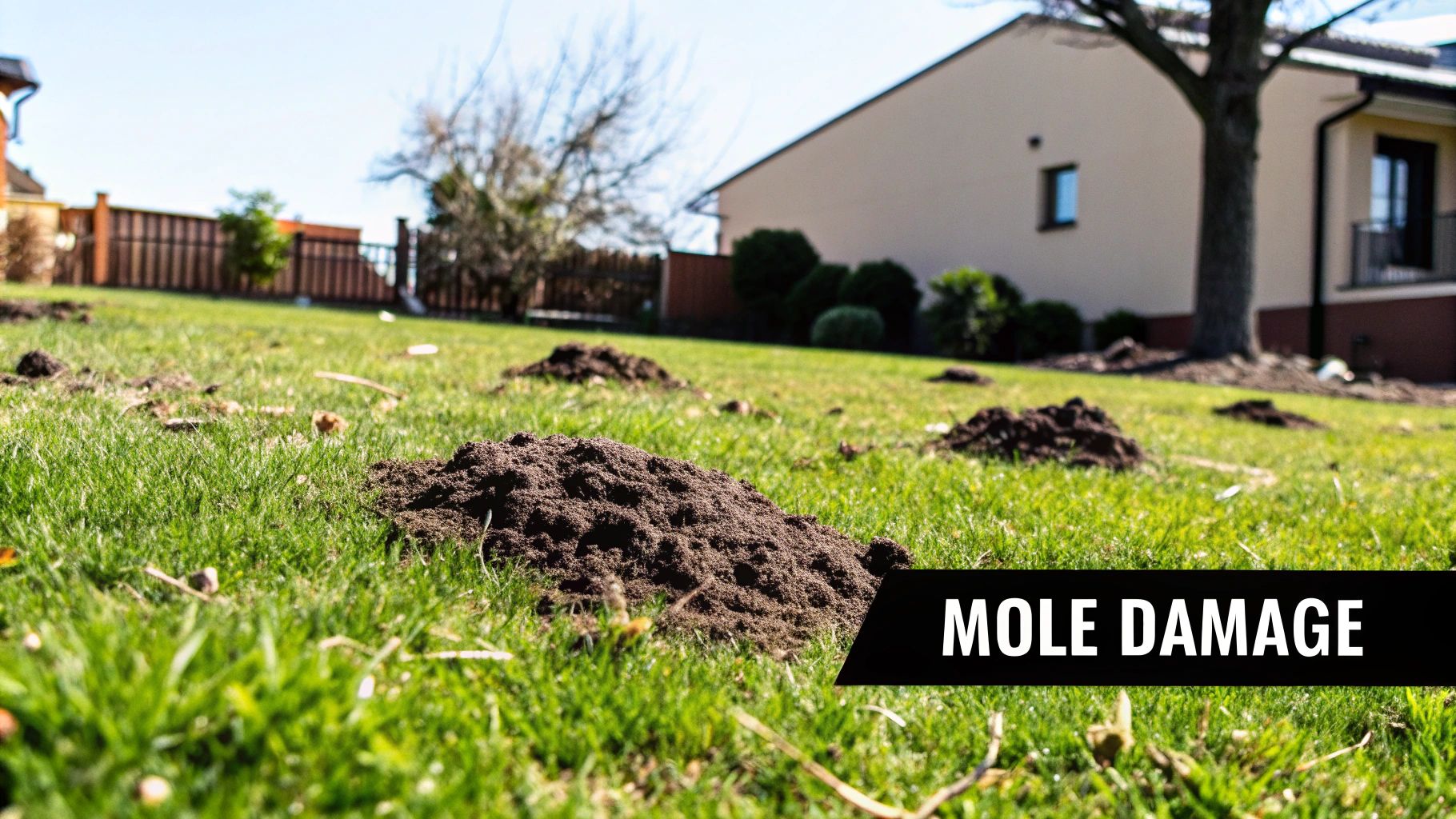Before you can even think about getting rid of a mole, you have to be absolutely sure that’s what you’re dealing with. The classic calling card of a mole is a garden dotted with those tell-tale, volcano-shaped mounds of soil. These are the molehills, and they’re basically the exit ramps from a much larger, hidden network of tunnels.
You’ll also often see raised ridges of earth snaking across your lawn. These are the shallow feeding tunnels, sitting just below the surface.
Confirming a Mole Infestation in Your Garden
It’s easy to blame moles for all sorts of garden damage, but their handiwork is often confused with that of other common culprits like voles or even rats. Getting it right is the first, most crucial step.
Moles are insectivores. This is key. They aren't tunnelling to chew on your prize-winning carrots or the roots of your rose bushes. They’re hunting for earthworms, grubs, and other insects. The real damage they cause is collateral—their constant digging severs and displaces root systems, starving plants of support and nutrients.
If you see patches of your lawn or plants suddenly wilting and dying for no obvious reason, a mole’s underground activity is a very likely cause.
The Tell-Tale Signs of Mole Activity
The most unmistakable sign is the molehill itself. These are piles of freshly dug soil pushed up from the mole's main, deeper tunnels. A key difference to look for: unlike the open holes left by rodents, molehills are sealed. You won't see a clear entrance.
Then there are the surface ridges crisscrossing your lawn. If you step on them, they often feel soft and spongy. These are the temporary tunnels moles create as they hunt for food right under the turf.
A single mole can cause an astonishing amount of chaos. These are solitary but incredibly efficient diggers, creating vast underground networks. In fact, one motivated mole can tunnel up to 20 metres in a single day, often lining its resting chambers with grass and leaves. You can learn more about their behaviour from the Millennium Pest Control team's expert insights.
Differentiating Moles from Other Pests
It’s incredibly important to distinguish mole damage from that of voles. Voles are small rodents that do eat plant roots, bulbs, and bark. Their tunnels look more like small, open trenches or runways on the surface of the lawn, and you might find gnaw marks at the base of trees or shrubs.
Moles, on the other hand, leave behind their signature closed mounds and raised ridges. Nailing the identification is the foundation of any successful removal strategy—what works for a mole won't work for a vole.
Mole Damage vs Other Common Garden Pests
Use this quick comparison to confirm if you're dealing with moles or another pest.
| Sign | Mole Activity | Vole or Rodent Activity |
|---|---|---|
| Diet | Primarily eats insects like earthworms and grubs. | Eats plant roots, bulbs, and stems. |
| Tunnels | Creates raised ridges just under the surface. | Creates visible, open runways on the grass. |
| Mounds | Forms volcano-shaped, sealed mounds of soil. | Leaves open holes, often about two inches wide. |
| Plant Damage | Indirect damage from root disruption. | Direct damage, including gnawed roots and bark. |
Once you've looked at the evidence and are confident a mole is the problem, you can start planning your next move.
Choosing Your Mole Removal Method

Right, you’ve confirmed you've got a mole. Now it’s time to decide on a battle plan. Choosing the best mole pest control removal method really comes down to your personal preference, the scale of the problem, and frankly, how quickly you want it sorted.
There’s no single ‘best’ way to do this. The most effective approach is always the one that suits your garden and your tolerance for these furry little architects. You can go for the direct approach with traps, or you can explore repellents and barriers if you're looking for a less hands-on or lethal strategy. Let's break down the main options.
The Effectiveness of Mole Traps
For professional pest controllers, trapping is the go-to method for one simple reason: it works. By physically removing the mole from your property, you're dealing with the problem at its source. There are a few different types of traps we commonly use in the UK, and each has its place.
- Scissor Traps: These are the traditional workhorses. They’re powerful and designed to be set right in the middle of a main mole run, triggered when the mole tries to clear the tunnel.
- Claw Traps (Duffus Traps): Very similar to scissor traps, these are also placed within a run and use a pincer-like claw action when the mole moves through.
- Tunnel Traps: Many people find these easier and safer to set. They're basically a tube that you place in the run with a spring-loaded trap inside, which goes off as the mole passes through.
But here’s the thing: the success of trapping isn’t really about the trap itself. It’s all about strategic placement. You have to find an active, primary tunnel. Stick a trap in a shallow, temporary feeding ridge and you’ll be waiting forever.
Exploring Repellents and Deterrents
The market is absolutely flooded with products that promise to just scare moles away. You’ll see everything from sonic spikes that buzz underground to granular repellents made from castor oil. And while the idea of a simple, no-fuss fix is tempting, their effectiveness is a hot topic of debate.
Sonic devices, for example, claim to irritate moles with vibrations. But think about it – moles are already used to the noise and vibration from lawnmowers, kids playing, and general foot traffic. From what I’ve seen, they might be put off for a day or two, but they often just learn to ignore the devices or dig a new tunnel around them. If you’re leaning towards less invasive methods, looking into some principles of eco-friendly pest control could give you some alternative ideas for long-term garden management.
The reality is that most repellents offer temporary relief, if any at all. Moles are driven by a powerful instinct for food. A lawn rich in earthworms is just too good a prize to give up over an annoying sound.
Physical Barriers as a Permanent Fix
If you want a truly long-term solution, especially for protecting a specific area like a prized flowerbed or your vegetable patch, then nothing beats a physical barrier. This involves digging a trench around the perimeter of the area and burying a barrier of hardware cloth or special mole mesh.
It's a lot of work, there’s no getting around that. But it’s also a one-time job that creates a permanent underground fence. It physically stops moles from ever getting into that protected zone, making it a powerful preventative measure rather than just a reaction to a problem. This is a brilliant approach for new gardens or if you’re already planning to redesign a section of your lawn.
A Practical Guide to Effective Mole Trapping
Of all the ways to handle a mole problem, trapping is still the most direct and reliable approach. While repellents and other methods can sometimes move them along, a well-placed trap physically removes the source of the lawn damage. But make no mistake, successful trapping is more of an art than a science; it hinges on understanding how these little excavators think and behave.
First things first, you need to play detective. The key is to find a primary, active mole run, not just one of the many temporary feeding tunnels they create. Think of these main tunnels as their underground motorways—the routes they use daily. You’ll often find them running along garden edges, paths, or fence lines.
A simple way to find one is to take a probe or even just a slender stick and gently push it into the ground between two molehills. When you hit a tunnel, you'll feel a sudden give as the probe breaks through. Found one? Great. Now, confirm it’s in use by pressing down a small section of the tunnel with your heel. Check back in 24 hours. If the collapsed section has been cleared and repaired, you've found your spot.
Preparing and Setting Your Traps
Once you've located an active run, it’s time to get your traps ready. This is where many DIY attempts fall flat. Moles have an incredible sense of smell and are instantly wary of human scent.
Always, always wear gloves when you handle your traps. You don't want to leave your scent all over the metal. Here’s a pro tip: if you’ve got a new trap, "season" it first by burying it in your garden soil for a few days. This helps it take on a natural, earthy smell that won't spook the mole.
Here's an infographic to help you visualise the process.
This visual guide breaks down the key stages, from locating that all-important active run to making sure your trap is properly concealed. A successful catch often comes down to getting these preparations right.
Best Practices for Trap Placement
When you’re ready to set the trap, carefully dig out a section of the tunnel just big enough for the device to fit snugly. The base of the trap needs to sit perfectly level with the bottom of the mole's run. Make sure the trapping mechanism—whether it's the claws of a Duffus trap or the loop of a tunnel trap—has a clear, unobstructed path.
After the trap is in place, it’s absolutely crucial to block out all light. A mole that sees daylight flooding its tunnel will get suspicious immediately. It will either plug the run with soil to block your trap or simply dig a new route around it. Cover the hole with a piece of turf, an upside-down bucket, or a wooden board—anything to ensure it's completely dark inside.
Remember, patience is key. Moles can be unpredictable. If a trap hasn't been sprung after a few days, don't just assume the mole has vanished. It might just be using a different part of its network. Simply pull the trap, find another active run, and try again.
Mole control in the UK is often most effective during their peak activity periods, which typically run from autumn through to spring. In these months, professionals deploy specialised scissor and tunnel traps in active runs, checking them daily over a treatment period of about five days. You can find more insights on seasonal pest patterns over at lodi-uk.com.
Keeping Your Lawn Mole-Free for Good
Getting rid of a mole is a great first step, but the job isn't finished. An empty tunnel network is basically prime real estate for the next mole that happens to wander through your garden. Real, long-term success with mole pest control removal comes from making your garden a less attractive place for them to settle down in the first place.
This means shifting your mindset from reactive removal to proactive prevention. It’s all about making small, sustainable changes to your garden that discourage new moles from ever breaking ground. The aim is to create a landscape that, from a mole’s perspective, just isn’t worth the effort.
Modifying the Garden Environment
Moles are drawn to our gardens for two simple reasons: plenty of food and soil that’s easy to tunnel through. If you can tackle these two things, you’ll dramatically reduce your garden’s appeal.
It all starts with their food source. A healthy lawn is full of earthworms, and you definitely don't want to get rid of those. But you can manage their secondary food sources, like grubs. Applying beneficial nematodes or using a targeted grub treatment can make your lawn less of a buffet. At the same time, improving drainage in soggy, waterlogged areas makes the ground less hospitable for both worms and moles.
Adopting a preventative mindset is the cornerstone of sustainable pest management. By making small, ongoing adjustments to the landscape, you create an environment that naturally deters pests rather than just reacting once they've caused damage. This approach forms the basis of what many professionals call Integrated Pest Management.
Installing Physical Barriers for Protection
For really important areas, like a prize-winning vegetable patch or a perfectly manicured flowerbed, a physical barrier is the ultimate line of defence. This involves digging a trench and installing a barrier of galvanised hardware cloth or a specialised mole mesh.
Here’s a quick rundown on how to do it:
- Dig a trench: You’ll want it to be at least 60cm deep and about 15cm wide around the area you want to protect.
- Install the mesh: Place the mesh in the trench, making sure it sticks up about 15cm above the ground. This stops the moles from simply climbing over it.
- Backfill the trench: Fill the trench back in, packing the soil down firmly around the mesh.
There's no sugar-coating it—this is a labour-intensive job. But the result is a permanent underground fence that moles simply can't get through. This strategy is part of a broader approach, and you can learn more about combining different methods by exploring the principles of Integrated Pest Management. For an even more robust deterrent, an electric fence like the Aquaforte Pond Defence 100 Electric Fence can create an effective no-go zone for moles.
Using Natural Planting Deterrents
Some plants are thought to have properties that naturally put moles off. While they're not a guaranteed fix on their own, planting them in your garden can add another useful layer of defence.
Plants like daffodils, marigolds, and alliums (think garlic and onions) are said to give off smells that moles can't stand. Planting these around the borders of your garden or near old tunnel runs can help persuade them to move on. It’s a simple, natural, and quite beautiful way to fortify your garden against future invaders.
When to Call a Professional Pest Controller

While DIY trapping can be a satisfying and effective solution for a lone mole, there are definite times when it’s wise to admit defeat and bring in the experts. Recognising these moments can save you a great deal of time, money, and frustration.
Calling for professional mole pest control removal isn't a failure on your part. Think of it as a strategic decision when you’re facing a particularly stubborn opponent.
One of the clearest signs is persistence. If you’ve correctly identified active runs, tried different traps, and followed all the best practices for weeks with no success, it’s time for backup. A particularly wary or "trap-shy" mole can be incredibly difficult to catch, and professionals have seen it all before.
Scenarios Demanding Expert Help
Another key factor is the scale of the problem. A single line of molehills across your lawn is one thing, but a vast network that spans several acres is another beast entirely. Large-scale infestations require a more systematic and intensive approach than most homeowners can manage on their own.
You should also consider calling in the pros for:
- Commercial or high-value properties: The turf on a sports pitch, bowling green, or formal garden is a significant asset. The risk of prolonged damage from mole activity often outweighs the cost of a professional service.
- Deep and complex tunnel systems: If moles are tunnelling deeply, making it hard to locate the primary runs, you'll need the specialised equipment and know-how that an expert brings.
- Recurrent infestations: If you successfully remove a mole only for another to appear a few months later, a professional can offer insights into the underlying environmental factors and provide more robust proofing solutions to stop the cycle.
A professional pest controller brings more than just traps to the job. They bring an expert eye, trained to quickly read the landscape, identify primary routes with incredible accuracy, and deploy the right equipment for your specific soil conditions and mole behaviour.
The Impact of a Changing Climate
Changing weather patterns here in the UK are also making mole problems more stubborn. Milder, wetter winters mean the ground rarely freezes solid, allowing moles to remain active and tunnel all year round. It’s no surprise this has contributed to a notable rise in demand for pest control services.
In fact, the UK pest control industry has seen steady growth, with revenues expected to reach an estimated £683 million in 2025. This trend aligns with Met Office reports of warmer and wetter years, which extend pest breeding cycles and shorten dormancy periods. You can find more detailed information on industry growth trends at ibisworld.com.
This environmental shift means that what used to be a seasonal nuisance is becoming a year-round battle, often requiring a more persistent and knowledgeable approach. When DIY methods fall short, exploring professional pest control services can provide the definitive solution needed to reclaim your lawn.
Your Mole Pest Control Questions Answered
Even with a solid plan, it’s natural to have a few lingering questions about how moles operate and the best way to deal with them. Getting straight answers can make the whole process feel less like guesswork and more like a strategy. Here, we tackle some of the most common queries we hear from gardeners across the UK.
Getting to grips with the habits of these persistent diggers is your first real step toward reclaiming the lawn. Lots of people are surprised to learn just how busy moles can be, especially as our UK climate keeps changing.
Are Moles Active All Year Round in the UK?
Because moles don’t hibernate, they’re technically active all year. But you’ll notice their digging activity really ramps up between autumn and spring — think October through to April. This is when the soil is damp and soft, making it perfect for them to tunnel through.
You'll definitely see the most molehills pop up during these cooler, wetter months. That said, with the UK’s winters becoming milder and wetter, it’s not unusual to spot fresh signs of mole activity at any time of year. Keeping an eye out has become a year-round job.
Should I Get Rid of Earthworms to Stop Moles?
Absolutely not. This is a common myth that can do serious damage to your garden's ecosystem. While it’s true that earthworms are a mole's main source of food, they’re also vital for healthy, aerated soil.
Trying to wipe out your earthworm population would hurt your lawn and plants far more than the moles ever could. It’s always better to focus on removing the moles themselves and then taking steps to discourage them from coming back. A healthy garden relies on a balanced environment, and worms are a crucial part of that.
A key part of successful mole pest control is knowing which tunnels are actually in use. Wasting time and effort on old, abandoned runs is a mistake I see all the time. Luckily, there's a simple, foolproof way to check.
How Do I Know if a Mole Tunnel Is Active?
This is surprisingly easy to figure out. Find a clear surface ridge or a fresh molehill and gently flatten a small section with your foot or the back of a spade.
Just make a mental note of the spot and check on it 24 hours later. If that flattened section has been pushed back up or repaired, you’ve found a live, active tunnel. This is exactly where you want to set a trap for the best chance of success.
If you're dealing with a stubborn mole problem that just won’t quit, don’t hesitate to bring in the experts. The team at Pest Predators Limited combines scientific know-how with practical experience to deliver effective, long-term mole removal. Visit our website to learn more about our professional services.



